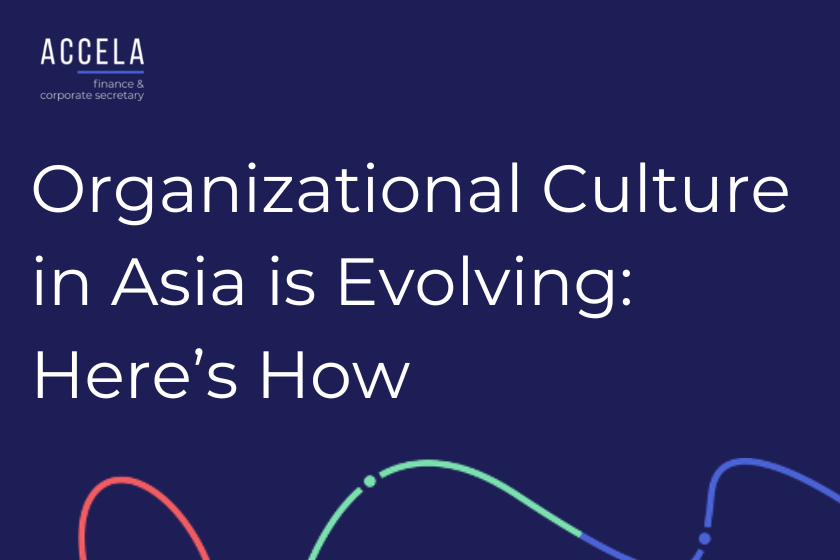Organizational Culture in Asia is Evolving: Here’s How
COVID-19 had a profound impact on ways of working for many people and organizations around the world. Remote work, flexible working hours, and virtual meetings are just a few ways organizations adapted to the post-pandemic business landscape – and businesses in Singapore were no exception.
Hybrid and Remote Work: Working in Singapore?
In Asia, transitioning to more flexible ways of work has been challenging, with Singapore’s working culture traditionally more oriented around hierarchy and controls. As the pandemic forced employees to work from home, some Singapore-based companies – like many organizations worldwide – saw productivity slip. Senior leaders, in turn, sought out controls and policies to gain closer oversight of remote and hybrid workers.
Many companies are now actively returning their teams to the office. However, the data shows that employees are breaking tradition and want more flexible working arrangements. Remote work models have become increasingly popular – PWC’s most recent survey on workers in Singapore shows that 70% of respondents work remotely, while 72% prefer working hybrid–above the global average.
Accela has seen first-hand how remote work has significantly impacted the business community in Asia, both positively and negatively. A successful transition to a long-term, flexible work policy depends on how well each business can mitigate the cons and capitalize on the pros of remote and hybrid work.
They include:
Overhead costs: Remote work reduces the need for large office space, reducing overhead costs such as rent, utilities, and office supplies.
Inclusivity: Flexible working arrangements benefit those with disabilities, caregiving responsibilities, and personal circumstances that limit their commuting distance. Proactively offering such flexibility attracts and retains a more diverse talent pool, allowing for greater inclusivity in the workforce.
Technology: Employers must ensure employees can access the necessary hardware and software to work remotely. Inconsistencies in technological capabilities and internet bandwidth are potentially tricky for businesses to manage.
Collaboration: Teams typically rely on in-person interactions to build camaraderie and rapport, positively impacting morale. While it is possible to achieve this remotely, the responsibility falls on senior management to proactively drive the culture shift, which can feel burdensome.
Cybersecurity: Remote work can pose cybersecurity risks for small businesses, mainly if employees use personal devices or networks to access valuable company information.
Employee Wellbeing in a Hybrid/Remote World
The link between the quality of life and the quality of one’s workplace has never been more apparent. Yet, even with the worst of the pandemic behind us, 1/3 of employees and executives still report excessive tiredness and mental health issues, which, if not addressed, will lead to burnout.
Accela’s recent blog post explained the importance of promoting work-life balance to avoid burnout. Many people find burnout hard to speak about, and to recognize the signs of it. Addressing burnout openly is a key factor in preventing it, or recognizing the signs. In Singapore, it can be difficult for people to speak openly about mental health challenges, and in a recent panel discussion at 1880 about the state of mental health in and the future of work, panelist Kelvin Ho (CEO, Nomura Singapore) said he found opening sharing his challenges with mental health and burnout with employees an important part of kicking off the conversations and inviting them to open up about their own struggles.
With growing concerns about burnout risk in Singapore and the broader Asian region, employers are doing more to implement strategies that help employees nourish their physical and mental health:
Mental health training and support: Business owners are investing in management training to help leaders notice the early signs of burnout and are offering benefits packages that include access to the appropriate resources. Organizations, such as WorkWell Leaders conduct research on the state of mental health in Singapore and share the research with businesses to help them build wellness strategies.
Taking breaks: Managers are encouraging their employees to go outside and physically move more throughout the day and are even incorporating team meditation, exercise, and well-being excursions into their cultural practices.
Regular communication: Employers are checking in more regularly with their employees so that they can identify risks of burnout as quickly as possible.
What Will Become of the ‘Grindset’?
The ‘grind set’ (grind mindset) concept emphasizes long hours, hard work, and constant productivity to improve one’s financial status. Asia’s work culture has historically been built on this as the norm.
While 61% of Singapore workers still prioritize pay, an increasing number of employees (particularly from younger generations) are looking beyond the number on their payslips - a significant cultural jump in the Asian market. Young workers are placing a heavier emphasis on work-life balance and meaningful work over financial security. By all measures, “grind” culture appears to be on a steady decline.
At Accela Group, we have seen an uptick in companies redefining their reward strategies and benefit schemes to attract and retain top talent. This includes more flexible working arrangements, inclusive leave policies, and designing new-age wellness programs. If you are a business owner or senior leader looking for guidance in this area, connect with us at hello@accela.asia.

